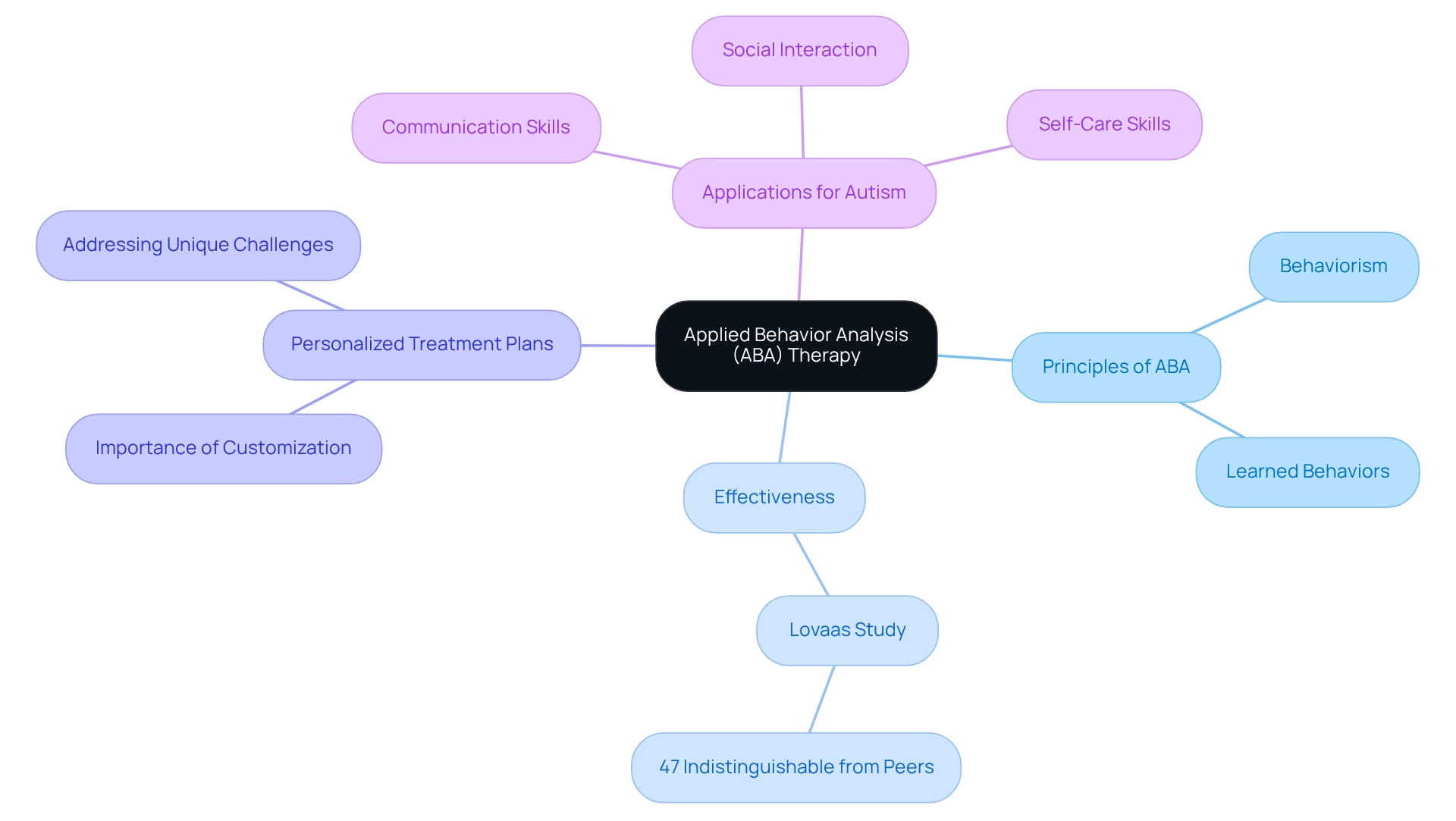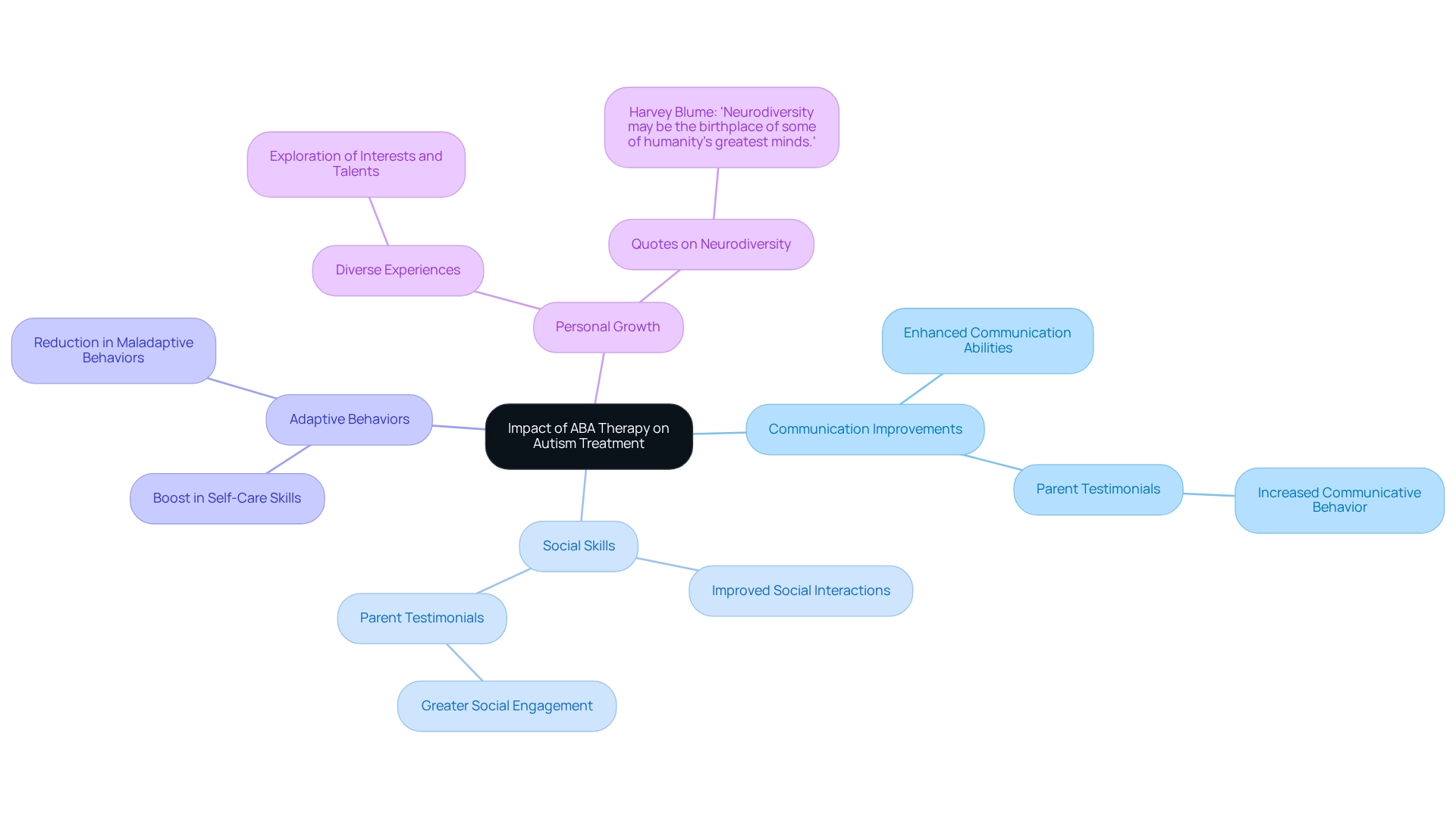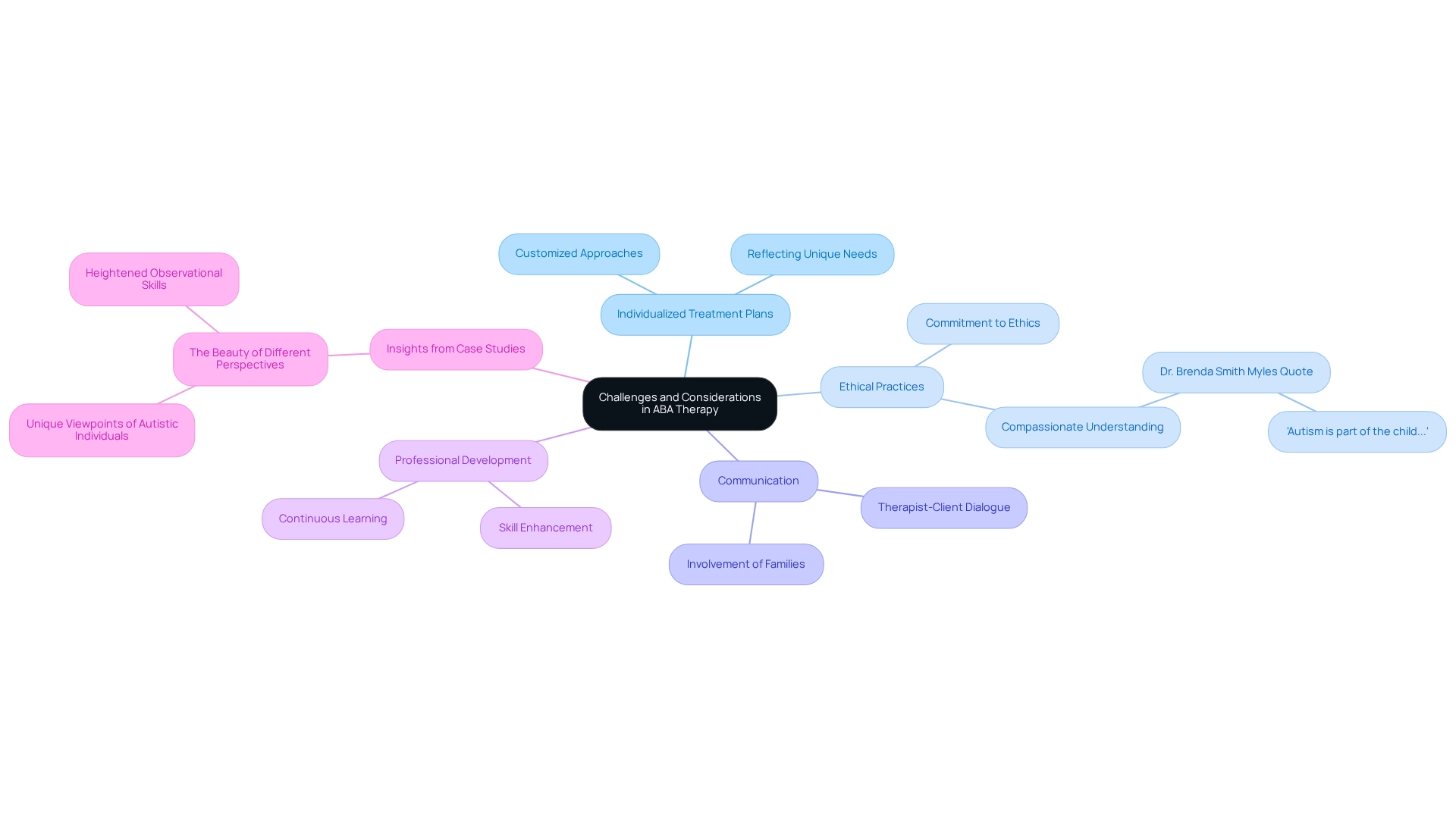Overview
ABA therapists play a crucial role in understanding and transforming behavior through personalized interventions that not only promote positive behaviors but also address challenging ones, especially for individuals with autism and developmental disorders. This compassionate approach is reflected in their responsibilities, which involve conducting thorough evaluations and creating individualized treatment plans. They employ a variety of techniques, such as Discrete Trial Training and Positive Reinforcement, aimed at nurturing skill development and enhancing the overall quality of life.
As parents, you may find comfort in knowing that these dedicated professionals are here to support your child’s journey. Their tailored strategies are designed to meet each child’s unique needs, fostering a sense of growth and progress. By focusing on what your child can achieve, ABA therapists help pave the way for a brighter future.
If you’re seeking more information about ABA therapy or looking for resources to support your child, don’t hesitate to reach out. Connecting with professionals in this field can provide valuable insights and guidance as you navigate this path together.
Introduction
In a world where autism diagnoses are increasingly common, the need for effective interventions is more critical than ever. Applied Behavior Analysis (ABA) therapy emerges as a scientifically validated approach, thoughtfully designed to enhance the lives of individuals with autism and other developmental disorders. By focusing on understanding and modifying behavior through personalized, structured interventions, ABA therapy empowers individuals to cultivate essential skills in communication, social interaction, and self-care.
As we recognize the complexities of autism spectrum disorders, the role of ABA therapists becomes vital. These compassionate professionals craft tailored treatment plans and employ various techniques to meet the unique needs of each individual. This article invites you to explore the principles of ABA therapy, the responsibilities of therapists, and the techniques they use, alongside the profound impact this therapy has on improving the quality of life for those affected by autism. We will also address the challenges and ethical considerations that accompany its practice, fostering a deeper understanding of this essential support system.
Define Applied Behavior Analysis (ABA) Therapy
Applied Behavior Analysis (ABA) intervention is a scientifically validated approach for understanding and changing behavior, grounded in the principles of behaviorism. This framework emphasizes that behaviors can be learned or unlearned through interactions with the environment. ABA treatment aims to enhance positive behaviors while reducing challenging ones, which is part of what ABA therapists do through structured interventions tailored to individual needs. This personalized approach is particularly beneficial for individuals with autism and other developmental disorders, fostering the development of essential skills such as communication, social interaction, and self-care.
A significant study by Lovaas revealed that 47% of children who received intensive ABA treatment were indistinguishable from their peers, underscoring the method's potential for meaningful improvement. As Ralph Moller points out, "It is crucial to consider the overlap in symptoms between autism spectrum disorder (ASD) and other disorders like attention deficit hyperactivity disorder (ADHD) to ensure that the treatment plan effectively addresses the individual's needs." This highlights the vital importance of individualized treatment plans that take into account unique challenges.
Moreover, recent research emphasizes the necessity of customizing interventions to effectively meet specific needs. With the prevalence of autism on the rise—recent reports indicate that over 1% of 8-year-old girls are now diagnosed—the demand for effective interventions like ABA becomes increasingly critical. What do ABA therapists do? They focus on the unique strengths and challenges of each individual to maximize the potential for progress in communication, social skills, and overall quality of life. If you are a parent navigating these challenges, know that support is available, and you are not alone on this journey.

Outline the Responsibilities of ABA Therapists
To understand what ABA therapists do, it's important to recognize their vital role in supporting individuals with autism and the range of responsibilities they carry out for effective intervention. Their primary duties, which illustrate what ABA therapists do, include:
- Conducting thorough evaluations to assess a client's existing abilities and behaviors, helping to identify specific areas for improvement.
- Developing individualized treatment plans that meet each client's unique needs.
- Implementing direct teaching, modeling, and reinforcement techniques designed to facilitate learning and promote positive behavior changes.
- Collecting data, which is a cornerstone of their practice, enabling therapists to monitor progress and make informed adjustments to treatment strategies.
- Regularly monitoring interventions to ensure they remain effective and aligned with the client's goals.
- Collaborating with parents, educators, and other professionals to cultivate a supportive environment that nurtures the client's growth and development.
Statistics indicate that approximately 90% of children experience significant improvements through ABA treatment, as noted by Dr. Ivar Lovaas. This underscores the effectiveness of these personalized approaches. Moreover, success stories highlight how ABA therapy empowers individuals with autism to lead more independent and fulfilling lives. Case studies further illustrate the importance of consistent data collection in tracking personal progress, allowing therapists to evaluate the success of their interventions and modify treatment plans as needed. This collaborative and data-driven approach is essential for fostering positive outcomes in the lives of individuals with autism.

Explore Techniques and Approaches Used in ABA Therapy
ABA therapy embraces a variety of methods designed to foster learning and inspire positive change in behavior. One of the most effective approaches is Discrete Trial Training (DTT). This structured method breaks down skills into small, manageable steps, allowing for focused teaching and reinforcement. The predictability of DTT is particularly beneficial for individuals with autism, as it creates a safe space for learning.
Another valuable technique is Modeling, where preferred actions are demonstrated for clients to replicate. This method shines in teaching social skills, offering a visual reference that can make learning feel more attainable.
Then we have Positive Reinforcement. This approach involves offering rewards or incentives to encourage the repetition of desired actions. Recent studies highlight how impactful positive reinforcement can be in shaping behavior, showcasing its essential role in ABA treatment.
Natural Environment Teaching (NET) takes a different angle by using everyday situations to teach skills in a more organic context. This not only promotes the generalization of learned behaviors but also enhances motivation and engagement. A case study on NET illustrated its effectiveness, demonstrating how skills can transfer across various environments. These techniques are often combined and tailored to meet the unique needs of each client, demonstrating what ABA therapists do to ensure that treatment is personalized. As ASD Media emphasizes, our understanding of autism has evolved, recognizing the complex factors that influence autism spectrum disorders. This awareness is crucial in the practice of ABA therapy, as it allows us to support each individual with compassion and insight.
If you’re a parent navigating this journey, know that you’re not alone. We encourage you to share your experiences and seek the resources that can help you and your child thrive.

Assess the Impact of ABA Therapy on Autism Treatment
Research consistently shows that ABA methods can lead to significant improvements for individuals with autism across various domains. For many parents, the journey can be challenging, but recent studies suggest that children involved in ABA interventions often demonstrate remarkable enhancements in communication abilities and social interactions, alongside a notable decrease in challenging behaviors. A comprehensive meta-analysis has revealed that intensive ABA intervention significantly boosts adaptive behaviors, such as self-care and social skills, while simultaneously reducing maladaptive behaviors.
Numerous parents have shared heartfelt testimonials about their children's development, highlighting the improvements in overall quality of life associated with ABA. One parent shared, "Since beginning ABA treatment, my child has become more communicative and social, which has made a significant impact on our family life." This powerful evidence underscores the essential role of ABA as a foundational treatment for autism, highlighting what ABA therapists do to equip individuals with vital tools to thrive in various aspects of life.
Moreover, the importance of exposing children to diverse experiences cannot be overstated. Such exposure allows them to explore their interests and talents, fostering personal growth and development. As Harvey Blume wisely stated, "Neurodiversity may be the birthplace of some of humanity’s greatest minds," reminding us of the value in nurturing diverse experiences to unlock potential. Together, let us support our children in their journey towards a brighter future.

Challenges and Considerations in ABA Therapy
While the effectiveness of ABA treatment is well-documented, it’s important to recognize the challenges that persist in its implementation. One key concern is the need for individualized treatment plans that truly reflect each client's unique needs and circumstances. Understanding the role of behavior is crucial in this context, highlighting the importance of customized approaches in ABA. It is essential to have skilled practitioners who are not only knowledgeable but also adhere to ethical practices throughout this process.
The ongoing discussions about specific ABA methods bring to light their potential impact on clients' emotional well-being. This underscores the necessity of maintaining open channels of communication between therapists, clients, and their families. As we navigate these conversations, it becomes clear that ABA treatment thrives on the wisdom shared by both therapists and patients, fostering a dialogue that can help overcome negative behavioral patterns. This dialogue is vital, ensuring that interventions are effective while remaining respectful and supportive.
Continuous professional development and a strong commitment to ethical guidelines are paramount for the success of ABA therapy. These elements create an environment where both therapists and clients can flourish together. Dr. Brenda Smith Myles poignantly reminds us, 'Autism is part of the child, not something that happened to them or that can be separated from who they are.' This statement emphasizes the need for a compassionate understanding of each individual’s experience.
Moreover, insights from case studies, such as "The Beauty of Different Perspectives," celebrate the unique viewpoints of autistic individuals, showcasing their distinct abilities and ways of engaging with the world. The commitment to ethical considerations and personalized approaches is essential in overcoming the challenges faced in ABA therapy today. Together, let us advocate for a future where every child's experience is honored and understood.

Conclusion
ABA therapy stands as a cornerstone in the treatment of autism, offering a structured and personalized approach to behavior modification that truly makes a difference. By defining the principles of Applied Behavior Analysis, outlining the responsibilities of therapists, and exploring the various techniques employed, it becomes evident that this therapy is not merely about managing behaviors; it’s about enhancing the overall quality of life for individuals with autism. The evidence supporting the effectiveness of ABA therapy is compelling, with numerous studies highlighting significant improvements in communication, social skills, and adaptive behaviors.
However, the journey of implementing ABA therapy is not without its challenges. The need for individualized treatment plans, ethical considerations, and ongoing communication between therapists, clients, and families is paramount. By fostering a compassionate understanding of each individual's unique experience, ABA therapy can truly empower those on the autism spectrum. The commitment to ethical practices and continuous professional development ensures that ABA remains a respectful and effective intervention.
As the prevalence of autism continues to rise, the importance of interventions like ABA therapy cannot be overstated. This therapy not only equips individuals with essential skills but also celebrates the diverse perspectives of those with autism. By embracing a holistic and individualized approach, ABA therapy paves the way for brighter futures, enabling individuals to thrive in their communities and lead fulfilling lives. Together, let us support one another on this journey, sharing resources and experiences that uplift and empower.
Frequently Asked Questions
What is Applied Behavior Analysis (ABA) therapy?
Applied Behavior Analysis (ABA) therapy is a scientifically validated approach for understanding and changing behavior, based on the principles of behaviorism. It focuses on enhancing positive behaviors while reducing challenging ones through structured interventions tailored to individual needs, particularly benefiting individuals with autism and other developmental disorders.
How does ABA therapy benefit individuals with autism?
ABA therapy fosters the development of essential skills such as communication, social interaction, and self-care in individuals with autism. A significant study indicated that 47% of children receiving intensive ABA treatment were indistinguishable from their peers, showcasing the method's potential for meaningful improvement.
What are the responsibilities of ABA therapists?
ABA therapists conduct thorough evaluations of clients' abilities and behaviors, develop individualized treatment plans, implement teaching and reinforcement techniques, collect data to monitor progress, regularly assess the effectiveness of interventions, and collaborate with parents, educators, and other professionals to support client growth.
Why is individualized treatment important in ABA therapy?
Individualized treatment is crucial because it addresses the unique strengths and challenges of each individual, ensuring that the therapy effectively meets their specific needs. This personalized approach enhances the potential for progress in communication, social skills, and overall quality of life.
What statistics support the effectiveness of ABA therapy?
Research indicates that approximately 90% of children experience significant improvements through ABA treatment. This statistic, along with success stories, highlights how ABA therapy empowers individuals with autism to lead more independent and fulfilling lives.
How do ABA therapists monitor progress in therapy?
ABA therapists collect data as a cornerstone of their practice to monitor progress. This data allows them to evaluate the success of interventions and make informed adjustments to treatment strategies as needed.
What should parents know about ABA therapy?
Parents should know that support is available for navigating the challenges associated with autism and that they are not alone in this journey. ABA therapy provides effective interventions tailored to their child's needs.




